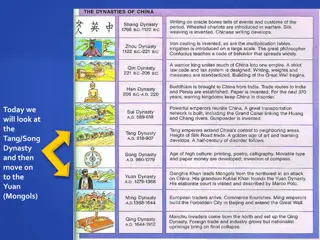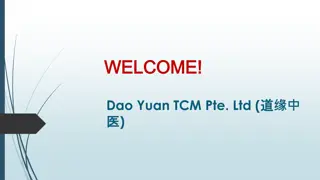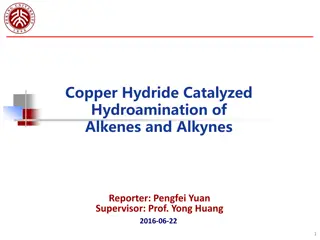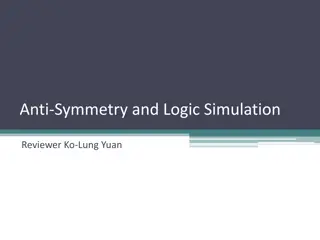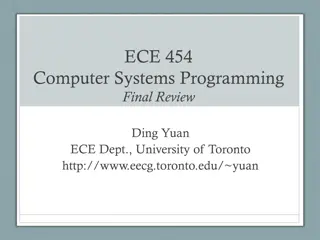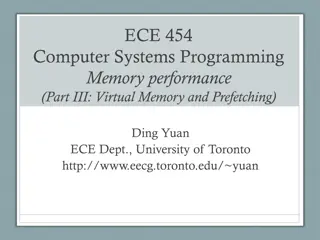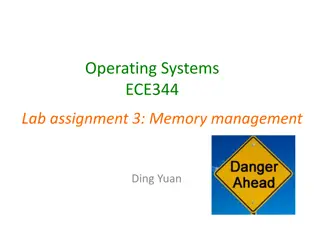
Stanmore Corporation Strategy Analysis and Balanced Scorecard Implementation
Analyzing Stanmore Corporation's strategy of product differentiation for its special-purpose machine, D4H, used in the textile industry. The discussion includes key measures for a balanced scorecard to enhance financial performance through price premium and higher margins.
Download Presentation

Please find below an Image/Link to download the presentation.
The content on the website is provided AS IS for your information and personal use only. It may not be sold, licensed, or shared on other websites without obtaining consent from the author. If you encounter any issues during the download, it is possible that the publisher has removed the file from their server.
You are allowed to download the files provided on this website for personal or commercial use, subject to the condition that they are used lawfully. All files are the property of their respective owners.
The content on the website is provided AS IS for your information and personal use only. It may not be sold, licensed, or shared on other websites without obtaining consent from the author.
E N D
Presentation Transcript
CH12 Strategy, Balanced Scorecard, and Strategic Profitability Analysis Group 5 LI Minyi, Mandy CHEN Shuwei, Rae YUAN Suxian, Susie WONG Bofung, Ivan ZENG Jiawen, Kamen HUANG Yunshi, Jimikou HUANG Wenxiu, Wendy
12- 22 Jimikou Susie Stanmore corporation makes a special-purpose machine, D4H, used in the textile industry. Stanmore has designed the D4H machine for 2013 to be distinct from its competitors. It has been generally regarded as a superior machine. Stanmore presents the following data for 2012 and 2013.
12-22 2012 2013 1.Units of D4H produced and sold 2.Selling price 3.Direct materials (kilograms) 4.Direct material cost per kilogram 5.Manufacturing capacity in units of D4H 6.Total conversion costs 7.Conversion cost per unit of capacity (row6/row5) 8.Selling and customer-service capacity 9.Total selling and customer-service costs 10.Selling and customer-service capacity cost per customer (row9/row8) 200 210 $40,000 300,000 $8 250 $2,000,000 $8,000 100 customers $1,000,000 $10,000 $42,000 310,000 $8.50 250 $2,025,000 $8,100 95 customers $940,500 $9,900
12-22 Stanmore produces no defective machines, but it wants to reduce direct materials usage per D4H machine in 2013. Conversion costs in each year depend on production capacity defined in term of D4H units that can be produces, not the actual units produced. Selling and customer-service costs depend on the number of customers that Stanmore can support, not the actual number of customers it serves. Stanmore has 75 customers in 2012 and 80 customers in 2013.
Is Stanmores strategy one of product differentiation or cost leadership? Explain briefly. 12-22(1) The strategy of Stanmore is product differentiation. From the question, we can know that D4H machine is designed to be distinct from competitor in 2013 and this machine is regarded as superior good. Furthermore, D4H is a special-purpose machine used in the textile industry. Therefore, it is concluded that Stanmore follows product differentiation strategy.
Describe briefly key measures that you would include in Stanmore s balanced scorecard and the reasons for doing so. 12-22(2) Balanced Scorecard measures for 2013 follow: Financial Perspective: (1)Increase in operating income from charging higher margins (2)Price premium earned on products Product differentiation generally drives to high price on product. That means higher price leads to higher margins or higher price premium can earn from products. These measures indicate that whether the product differentiation strategy could benefit the increase of operation income by charging premium prices.
Customer Perspective (1) Market share in high-end special-purpose textile machines (2) Customer satisfaction (3) New customers 12-22(2) This perspective identifies targeted customer and market segments and measures the company s success in these segments. To monitor its customer objectives, Stanmore s strategy should result in improvements in these customer measures that help evaluate whether Stanmore s product differentiation strategy is succeeding with its customers. These measures are leading indicators of superior financial performance.
Internal-business-process Perspective (1) Manufacturing quality and reduced wastage of direct materials (2) New product features added (3) Order delivery time 12-22(2) This perspective focuses on internal operations that create value for customers that, in turn, help achieve financial performance. Improvements in these measures are expected to result in more distinctive products delivered to its customers and in turn superior financial performance.
Learning-and-growth Perspective (1) Development time for designing new machines (2) improvements in manufacturing processes (3) employee education and skill levels (4) employee satisfaction 12-22(2) This perspective identifies the people and information capabilities necessary for an organization to learn, improve, and grow. These capabilities help achieve superior internal processes that in turn create value for customers and shareholders. Improvements in these measures are likely to improve Stanmore s capabilities to produce distinctive products that have a cause- and-effect relationship with improvements in internal business processes, which in turn lead to customer satisfaction and financial performance.
12-16 Mandy Wendy Ivan Ridgecrest Electric manufactures electric motors. It competes and plans to grow by selling high-quality motors at a low price and by delivering them to customers quickly after receiving customer s orders. There are many other manufacturers who produce similar motors. Ridgecrest believes that continuously improving its manufacturing processes and having satisfied employees are critical to implementing its strategy in 2013.
Is Ridgecrests 2013 strategy one of product differentiation or cost leadership? Explain briefly. 12-16(1) Ridgecrest s 2013 strategy is a cost leadership strategy. Ridgecrest plans to grow by producing high-quality boxes at a low cost delivered to customers at a low price and in a timely manner. Ridgecrest s are not differentiated, and there are many other manufacturers who produce similar boxes. To succeed, Ridgecrest must produce high- quality boxes at lower costs relative productivity and efficiency improvements. to competitors through
12-16(2) Kearney Corporation, a competitor of Ridgecrest, manufactures electric motors with more sizes and features than Ridgecrest Kearney s motors are of high quality, but require more to produce and so have longer delivery times. Draw a simple customer preference map as in Exibit 12-1 for Ridgecrest and Kearney using the attributes of price, delivery time, quality and design features. at a higher price.
This picture shows the customer preference map for electric motors for Ridgecrest and Kearney on price, timeliness, quality, and design. Customer preference map for electric motors 12-16(2) attributes Ridgecrest Kearney Corporation higher price price low price delivery time quality quickly longer high quality high quality design features similar more sizes and features
12-16(3) Draw a strategy map as in Exhibit 12-2 with two strategic objectives you would expect to see under each balanced scorecard perspective.
Increase Operating Income From Productivity Grow Operating Income Financial Perspective Reduce Cost Increase Market Share in Electric Motors Market Increase New Customers Increase Customer Satisfaction Customer Perspective Internal Business Process Perspective Improve Manufacturing Processes Deliver on Time Improve Quality Improve Productivity Align Learning and Growth Perspective Develop Process Skill Employee and Organization Goals
For each strategic objective indicate a measure you would expect to see in Ridgecrest s balanced scorecard for 2013. 12-16(4) Measures that we would expect to see on a Ridgecrest s balanced scorecard for 2013 are Financial Perspective 1. Operating income from productivity gain 2. Operating income from growth 3. Cost reductions in key areas These measures evaluate whether Ridgecrest has successfully reduced costs and generated growth through cost leadership.
Customer Perspective 1. Market share in electric motors market 2. Number of new customers 3. Customer satisfaction 12-16(4) The logic is that improvements in these customer measures are leading indicators of whether Ridgecrest s cost leadership strategy is succeeding with its customers and helping it to achieve superior financial performance. Internal Business Process Perspective 1. Productivity 2. Order delivery time 3. On-time delivery 4. Number of major process improvements Improvements in these measures are key drivers of achieving cost leadership and are expected to lead to more satisfied customers and in turn to superior financial performance.
12-16(4) Learning and Growth Perspectives 1. Percentage of employees trained in process and quality management 2. Employee satisfaction ratings Improvements in these measures aim to improve Ridgecrest s ability to achieve cost leadership and have a cause-and-effect relationship with improvements in internal business processes, which in turn lead to customer satisfaction and financial performance.
An analysis of Ridgecrests operating-income changes between 2012 and 2013 shows the following: 12-17 Kamen Rae Operating income for 2012 Add growth component Deduct price-recovery component Add productivity component Operating income for 2013 Change in Operating Change in Operating income $1,900,000 95,000 F (82,000) U 160,000 F $2,073,000 173,000 173,000 F F income The industry market size for electric motors did not grow in 2013, input prices did not change, and Ridgecrest reduced the prices of its motors.
Was Ridgecrests gain in operating income in 2013 consistent with the strategy you identified in requirement 1 of Exercise 12-16? 12-17(1) Ridgecrest s operating income gain is consistent with the cost leadership strategy identified in requirement 1 of Exercise 12-16. How much of the $173,000 increase in operating income was caused by the company s cost-leadership strategy. To analyze three factors: (1) growth, (2) price recovery, and (3) productivity. Growth component: the change in operating income attributable solely to the change in the quantity of output sold between 2012 and 2013. Price-recovery component: the change in operating income attributable solely to changes in prices of inputs and outputs between 2012 and 2013.
Was Ridgecrests gain in operating income in 2013 consistent with the strategy you identified in requirement 1 of Exercise 12-16? 12-17(1) Productivity component: the change in costs attributable to a change in the quantity of inputs used in 2013 relative to the quantity of inputs that would have been used in 2012 to produce the 2013 output. The increase in operating income in 2013 was driven by the $160,000 gain in productivity in 2013. Ridgecrest took advantage of its productivity gain to reduce the prices of its motors and to fuel growth. It increased market share by growing even though the total market size was unchanged.
Explain the productivity component. In general, does it represent savings in only variable costs, only fixed costs, or both variable and fixed costs? 12-17(2) The attributable to a change in the quantity and mix of inputs used in a year relative to the quantity and mix of inputs that would have been used in a previous year to produce the current year output. It measures the amount by which operating income increases and costs decrease through the productive use of input quantities. When comparing productivities across years, the productivity calculations use current year input prices in all calculations. Hence, the productivity component is unaffected by input price changes. productivity component measures the change in costs
12-17(2) The productivity component represents savings in both variable costs and fixed costs. With respect to variable costs, such as direct materials, productivity improvements immediately cost savings. In the case of manufacturing conversion costs, productivity gains result only if management takes actions to reduce unused capacity. For example, reengineering manufacturing processes will decrease the capacity needed to produce a given level of output, but it will lead to a productivity gain only if management reduces the unused capacity by, say, selling off the excess capacity. translate such into fixed fixed costs, as


